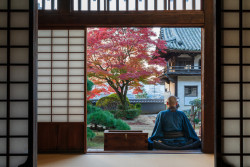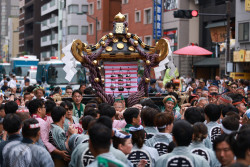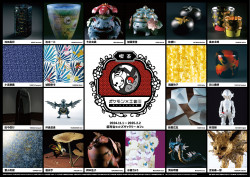
Originally published on metropolis.co.jp on August 2011

Since World War II, the schizophrenic city of Tokyo has a well-documented substratum to compare with its skyscrapers and citizens racing each other to reach the sky. Tokyo’s rich underground culture takes many bizarre and diverse forms. Fetish culture, such as S&M and cosplay, are just the tip of the iceberg of the sex-related industry, in which the pioneering Japanese have invented many genres of their own.
Shibari—Japanese bondage—is the perfect example. Despite the fact that a natural human sensibility underlies this art of rope, it is often belittled by society owing to its fetishist origins.
Japan’s leading rope artist-cum-kimbakushi (Japanese bondage master) Kinoko Hajime has been in the field for over a decade now, and is renowned for his mad rope techniques and sheer artistic qualities. He dominates the field of inanimate object bondage, which involves tying up such things as roast pork, figurines, and even Mount Fuji’s Sea of Trees; and cyber rope, a neo-kimbaku which harnesses black light and fluorescent colored ropes to create a spectacle of light and silhouette. His artworks evoke not only eroticism but nostalgia, maternal love and other sensations amid spectators. Kinoko’s world is somewhat like a dense fog; it transfigures the world, while embracing you in its aura. But no-one can explain it as well as the artist himself.
“Kimbaku is a sect within the shibari (rope) philosophy,” explains Hajime. “It’s a method of communication exclusively between people, whereas shibari can be practiced with objects. In the grand theater of kimbaku the bondagees are the protagonists and the kimbakushi are just the supporting actors. What the kimbakushi do is to perceive, then depict, the subject’s aspirations, and the character of the moment. They do this by using their hands, which in our case is the rope. Factors such as superficial tension, sweat, respiration, corporal oscillation and the pulse of the bondagee are important information, which the rope transmits to us. Therefore each piece of kimbaku has its unique color.”

Hajime hopes to spread this philosophy and transform the opinion of society. Cyber rope was invented by the artist and his followers as a gateway to rope for general audiences, putting more emphasis on the entertainment side of kimbaku. And it is far more accessible to the first-time viewer. In the darkness, the bondagee appears as a silhouette with the UV-sensitive colored ropes exploding into view under the introduction of black light.
However, the standard shibari wins many converts among people who might have expected something seedier and more grotesque. Spectators are surprised by the gentleness and senstivity of the performance, something which explores the complexity of certain base human emotions and creates something unique every time. There is something more than just manual dexterity at work in the performance of the artists.
“After a kimbakushi obtains a certain range of techniques it is his/her qualities as a human being that define his/her skills,” says Hajime. “In order to understand and express the instantaneous innermost nature of a bondagee, you must be sensitive and perceptive. Naturally these essentialities can’t be taught. Just as there are always people you get along with and those with whom you just don’t.”
To take your first ropy steps in this arcane art, head to Kinoko’s own bar in Shibuya, Bar Sleeping Beauty, for his workshop Shishioto-Nawa-Kai, on the first and third Sunday every month. Beginners take classes from 4-7:20pm. Classes are ¥2,000 each, though first time attendees must pay membership (men ¥7,000 and women ¥2,000). Get 50% off membership when you mention Metropolis, valid up to one month from publication. For private lessons with the maestro himself, email kinoko@shibari.jp. Find out more about Kinoko at http://shibari.jp/en.







